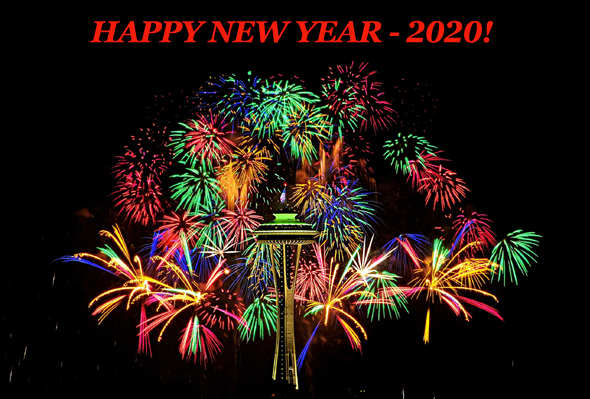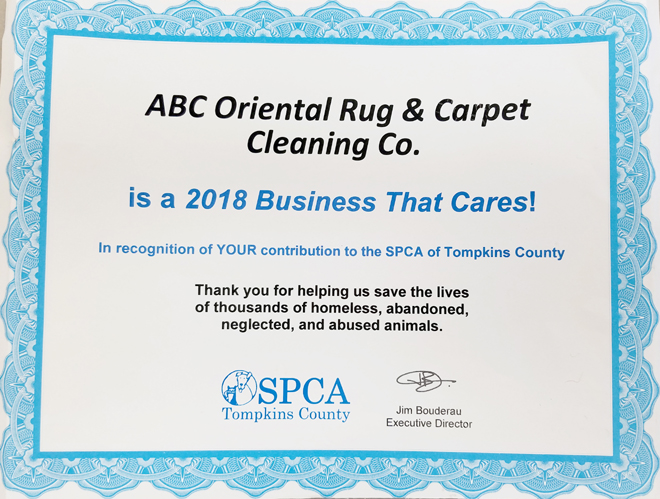ABC MONTHLY NEWSLETTER
JANUARY 2020
Welcome to Our Monthly Newsletter!
We hope you will enjoy this month's articles.
Wishing you a wonderful New Year
filled with
love, luck, and prosperity!

This month's topics are:
AREA & ORIENTAL RUGS
CARPET CLEANING
MISCELLANEOUS
New Year Superstitions - Some Fun Trivia
If there is a topic you would like us to cover in one of our upcoming newsletters, please call us at
607-272-1566
or contact us by clicking here.
GREAT NEWS!
GOT QUESTIONS?
NOW YOU CAN TEXT US at
607-272-1566
REMINDER:
Don't forget to keep checking our website for our beautiful
You are always welcome to come in and check them out for yourself as well!
MILAS ORIENTAL RUGS
LOCATION and HISTORY
Milas oriental Rugs (Melas) are Turkish rugs woven in the district of Milas in Mugla Province in southwestern Turkey. Milas is an ancient city with a very rich history and a large number of noted ancient archaeological sites. One of these is the nearby Mausoleum of Hecatomnus, classified by UNESCO as a World Heritage Site. The city of Milas is the seat of the district and today it commands a region with an active economy.
The peoples of the region of Milas have been able to keep their Turkmen (semi-nomadic lifestyle) heritage alive, a heritage which includes the passing down of the art of rug weaving through generations of its women, as well as its distinctive clothing, traditions, and customs.
It is believed that a very distinctive type of the Milas oriental rugs emerged in the 16th century. These were 'seccade' or small prayer rugs. By the 18th and 19th centuries, other types of distinctive Milas rugs could be classified based on their colors and designs.
The 19th century saw the launching of the Orient Express train which brought more and more Europeans to Turkey for trade purposes as well as to visit famous cities such as Constantinople. The European influence on the art and architecture of the ruling Ottoman Empire was enormous.
Variants of Milas oriental rugs include the Ada Milas, Patlicanli, Cingilli Cafer, Gemisuyu, and Elkoynunda, etc, depending on style, colors, and other characteristics.
TYPES & DESIGNS OF MILAS ORIENTAL RUGS
CLASSIC MILAS ORIENTAL RUGS
These Milas oriental rugs are closest to the original 16th century prayer rugs (seccade) mentioned above. The oldest examples of these classical rugs are the Ada Milas Rugs.
The word 'ada' has several origins and may come from a word meaning island, referring to the island where the immigrants who first wove the rugs may have come from. The name could also come from the stylized carnation bouquet and tulip motifs that were often woven into the rugs.
The Ada Milas rugs usually contained a rather narrow, usually brick red rectangular prayer niche or 'mihrab.' This marked the spot on which the forehead touched the rug while kneeling for prayer. The side of the niche would usually have several different plant motifs. A specially designed field called the 'alem' was usually woven above the niche where the 'heavenly promises' could be found.
Additionally, the Ada Milas rugs tended to have wide borders and small fields and their colors were more muted than other types of Milas rugs.
Motifs such as cat's paws, soles, notches, etc. could often be found in an abstract manner on the sides of the rug, usually in a repetitive order.
Today, the Ada Milas rugs are woven in the village of Karaova.
BAROQUE STYLE MILAS RUGS
As mentioned above, the 19th century launching of the Orient Express brought the European influence to Turkey. The Baroque style of Milas oriental rugs was the result. Flower designs in a zigzag pattern replaced the ordered and abstract motifs of the classical Milas rugs.
MEDALLION MILAS ORIENTAL RUGS
This group of Milas rug began in the village of Karacahisar near the city of Milas. The rugs still being produced in this village and its surrounding area are based on the early Karachisar rugs.
These rugs do not have the niche or the alem as in the prayer rugs, but are characterized by a centrally situated and larger field called the 'gobek.'
Medallion-like motifs surround this field as well as abstract leaves and branch motifs which are woven along the sides. They are always woven on a bed of white and red. The Karacahisar rugs are not as tightly woven as the prayer rugs.
Medallion design Milas rugs can also contain a large central medallion placed within a small field.
CONSTRUCTION OF MILAS ORIENTAL RUGS
FOUNDATION
The warp (up and down cords) is made up of 2 or three strands of wool, occasionally cotton as well. These strands can often be found colored in blue or pink and they can form a rather long, loose, and unattractive fringe.
The weft is usually 2 or more shoots of wool, dyed red in older rugs and golden yellow in newer rugs. Occasionally, cotton is used. These red and yellow wefts are how Milas rugs stand out from other Turkish rugs, especially when an extravagant amount of yellow is used.
PILE
The pile is wool and is generally medium to medium long in length.
KNOT
The knot is the symmetrical Turkish or Ghiordes.
ENDS
The ends have a kelim (flat area) with plain fringe at both ends.
SIDES
The sides consist of 2 to 4 cords, wrapped with weft cords or overcast with wool.
COLORS OF MILAS ORIENTAL RUGS
Muted colors were generally used in the older rugs as well as natural dyes. Brown came from walnut leaves, reddish brown from the Erica vulgarus (similar to heather) shrub, extremely dark yellow from the leaves of the peach and apricot trees, brownish yellow from acorns, and green from mint were the usual colors found in these rugs.The wool itself could be blackened by leaving it in the ground for a week. Before 1870 a purple brown, almost a violet, could be found from the use of the dye from the Cochineal insect.
Colors used for current weaving in Milas rugs are light beige, light brown, yellow, and light green. Natural dyes are still widely in use. When aniline or synthetic dyes are used, the colors in the modern Milas oriental rugs may appear too brilliant and not harmonious. Although, they may seem garish at first, as the colors fade over time, they can become more attractive.
SIZES OF MILAS ORIENTAL RUGS
Please continue reading here for more information and photos of Milas Oriental Rugs, as well as for information on the status of Milas weaving today.
WINTER CARPET CLEANING-WHY?
Winter carpet cleaning when the snow falls, the wind blows, and the temperature drops? Why?
You may think, why in the world would I open my nice comfy, warm home to the outside just to get my carpets cleaned? Why not just wait until Spring?
Well, there are some very good reasons why having your carpets professionally cleaned in the winter months, especially January, February, and March, is a great idea and makes perfect sense...
HERE ARE SOME REASONS WHY...
NUMBER 1...
IT IS EASIER TO GET A CARPET CLEANING APPOINTMENT DURING THE WINTER MONTHS
Why wait for company to come or for a special event or even an emergency?
Schedule a professional carpet cleaning during the colder months before the springtime when companies become extremely busy. You can avoid the rush and keep your carpets at an optimal level of fresh and clean all winter.
Don't forget, if there are spots and spills from holiday entertaining, these can turn into permanent stains the longer you wait to get your carpets professionally cleaned. The more soil builds up in the carpet, the harder it is to remove.
NUMBER 2...
YOU WILL SAVE MONEY
Most professional carpet cleaning companies (including ABC!) offer discounts to their customers during the slower winter months.
NUMBER 3...
HELP TO MAINTAIN A HEALTHIER INDOOR ENVIRONMENT
During the warmer months allergens such as pollen, dust, and other airborne pollutants enter your home through open doors and windows.
These allergens become trapped in our homes when we seal them up to keep the cold out. Your carpet keeps those allergens trapped in its fibers but if the carpets are not cleaned regularly, they get saturated and the allergens are released into the air, negatively impacting indoor air quality.
When you have your carpets professionally cleaned in the winter, those allergens will be eliminated, leading to better indoor air quality so everyone will be able to breathe easier.
NUMBER 4...
IT IS NOT JUST OUTDOOR ACTIVITIES THAT DIRTY YOUR CARPET!
In the colder months, we tend to stay indoors more and allergens from cooking and heating sources can also be trapped in our homes.
NUMBER 5...
CARPETS MAY ACTUALLY DRY FASTER IN THE WINTER
If you thought your carpets would not dry fast enough after a winter carpet cleaning, you will be pleased to know that carpets cleaned in the winter, in most cases, will actually dry faster!
This is because the humidity is lower, helping the moisture to evaporate more quickly. Warm humid air cannot hold as much moisture as dry air.
The professional carpet tech also brings high-powered fans into your home to help dry your carpets even faster to make them available for foot traffic sooner.
NUMBER 6...
EXTEND THE LIFE OF YOUR CARPETS
You may ask why clean carpets in the winter when they will just get dirty again come Spring?
Because to extend the life of your carpets, it is important to keep them clean throughout the year. The longer soiling remains in the carpet, the more damage it can do to carpet fibers. Soil particles cut away at the carpet fibers, shortening its life expectancy.
STEPS TO KEEP YOUR JUST CLEANED CARPET LOOKING CLEANER LONGER
Please continue reading here for more information about winter carpet cleaning.
FROZEN PIPES
THAWING and PREVENTION
Frozen pipes not only mean the inconvenient lack of water, they also can burst, causing an expensive repair problem.
Homeowners are often understandably frantic to get water pipes running again. But thawing the pipes improperly can lead to more problems.
THAWING FROZEN PIPES
If there are pipes located against an outside wall, in an uninsulated area of the basement, crawl space or attic, they need your immediate attention. If you have an outside faucet, this can also be a problem area.
CAUTION: Never use a device with a flame to thaw out pipes! A little heat on the right pipe could get that water flowing. But a flame on the pipe is a very bad idea!
According to fire experts, flames under the house, even when directed at pipes, are a common cause of fire. The open flame from a heater, especially a propane salamander, can instantly ignite insulation or flooring materials under a house.
Even worse, pipes can heat up dramatically from flaming devices allowing heat to travel along the piping systems inside walls. This heat can ignite wall materials. The fire can smolder for hours before being discovered, or bursting into flame.
According to the Red Cross, excessive heat on metal piping can also cause water to boil, resulting in a burst pipe.
If you do not know where the pipes are frozen, do the following:
- It is a good idea to turn up the heat in the house while you are looking for the frozen pipe. The affected pipe may be inside a wall or another difficult-to-access location; if this is the case, the time spent trying to track it down could be just enough for the pipe to reach the bursting point. Having additional heat circulating through the home may buy some time.
- First, open the faucets and then apply heat with a hair dryer or electric heating pad. Keep the faucets open. As you treat the frozen pipe and the frozen area begins to melt, water will begin to flow through the frozen area. Running water through the pipe will help melt ice in the pipe.When using hair dryers, heat lamps or heaters on a frozen pipe close to a wall, try sliding a cookie sheet or aluminum foil between the pipe and wall to reflect as much heat as possible toward the pipe.
- If no hair dryer or electric heating pad is available, you can soak towels in hot water and wrap them around the pipes. Keep heat on the pipes until full water is restored.
- Know where you main water supply is. If a frozen pipe does burst, immediately shut off water to the house. If the pipe is in an accessible location, you can then thaw what remains in the pipe, collecting what melts. While the damage to the pipe will have already been done at that point, this will save you from further - and more severe - water damage. You can then decide whether you want to attempt a temporary repair, or call a licensed plumber immediately.
PREPARE AHEAD OF
VERY COLD TEMPERATURES
If you know your pipes are prone to freezing here are some simple steps to take ahead of very cold weather:
- Give yourself a supply of water. You can partially fill a bathtub with water when very cold temperatures are predicted. This can provide water for pets, cleaning, or bathing. It will also give you some breathing room so you can take your time unfreezing pipes.
- Keep faucets open to a drip. This will help prevent pipes from freezing. Although this can put a strain on water pump systems, it is usually better than broken pipe disasters.
- Close garage doors, especially if there are pipes along the garage walls.
- Open your cabinet doors in the kitchen and bathroom to allow warm room air to circulate.
- Don't turn down the house temperature during very cold nights. Never set the thermostat to less than 55 degrees when the weather will be below zero.
LONG-TERM PROTECTION
FROM FROZEN PIPES
Please continue reading here for more information about frozen pipes.
NEW YEAR SUPERSTITIONS
Some Fun Trivia
New Year superstitions abound and may differ according to regions of the country. Here are a few you may know about and a few that may amuse you:
Fireworks and Loud Revelry
In many cultures, noise drives out evil spirits.
Let Out the New Year
At midnight, open all the doors of your house to let the old year escape unimpeded.
Images of a Baby with a Banner
As early as 600 B.C., the Greeks were using this imagery to represent the birth of a new year.
Kissing at Midnight
Smooching our favorite people ensures our ties will continue throughout the New Year.
Resolutions
Early Babylonians made promises to return borrowed farm equipment, but modern people are more likely to swear off smoking and liquor.
Eat Black-Eyed Peas, Collard Greens and Corn Bread
This Southern tradition has gained favor nationally. Black-eyed peas symbolize prosperity because peas swell when cooked. Collard greens represent money and cornbread symbolizes gold.
Take Nothing Out of the Door on New Years Day
That means nothing, not even garbage should leave your house on New Year's Day.
Don't Eat Chicken or Turkey on January 1
If you do, like these birds, you will scratch in the dirt all year long for your dinner!
Don't Wash Your Laundry on New Year's Day
If you do, a family member may be 'washed away.'
Don't Cry on the First Day of the Year
Tears set the tone for the next 12 months.
Happy New Year and don't forget,
2020 is a Leap Year as well!
JANUARY SPECIALS
It's the First Month of Our
Regular Customer Appreciation Discount
(RCAD)
All Month Long...
20% Off
All Wall-to-Wall Carpet Cleaning
30% Off
All Upholstered Furniture Cleaning
AND
Pay with Cash or Check
for an extra
5% Off!
PLUS
More Cleaning Specials for
YOU
and Your Family & Friends!
Please call our office at
607-272-1566
for details!
For info on RCAD,
please click here.
AN ADDITIONAL SPECIAL FOR JANUARY...

THANK YOU!! WE LOOK FORWARD TO CONTINUING TO SERVE YOUR TEXTILE CLEANING AND REPAIR NEEDS!
Get New Posts Right To Your Inbox!
Get our monthly newsletter, just like this one, delivered right to your inbox each day. Just sign up and we will send you the best new articles and videos as they become available.
Your email address will NEVER be spammed, sold, or shared. You are welcome to unsubscribe at any time with the link in the email.
Top of January 2020 Newsletter
"The Cleanest Clean You've Ever Seen."
by
ABC Oriental Rug & Carpet Cleaning Co.
130 Cecil Malone Drive Ithaca, NY 14850
607-272-1566

ABC
Carpet & Rug
Spotting Guide

ABC Oriental Rug & Carpet Cleaning Co. has been family-owned and operated in Ithaca and surrounding areas for more than 48 years.
Our company is a reflection of our family name and pride.
Please Like us on Facebook!
for more information and to find out what we are doing at our business and in the community!
Stay Connected!
Links to Our Services
Allergy Cleaning
Area Rug Cleaning
Oriental Rug Cleaning
Rug Hand & Machine Repair
Upholstered Furniture Cleaning
Tile & Grout Cleaning & Sealing
We are proud sponsors of the SPCA of Tompkins CO:

Newsletter Archives

